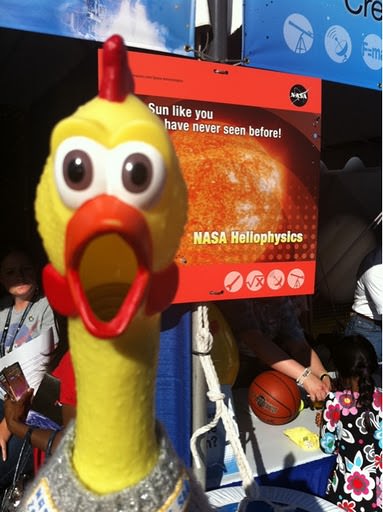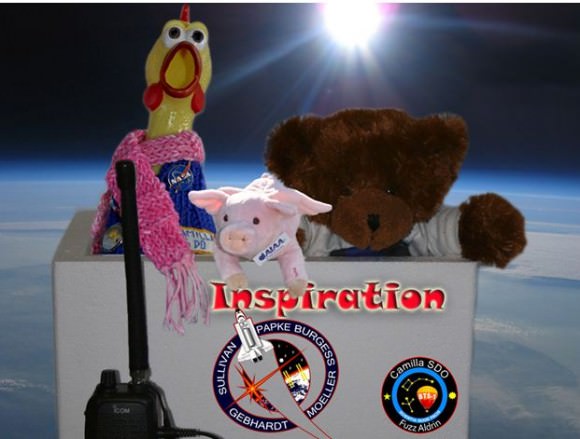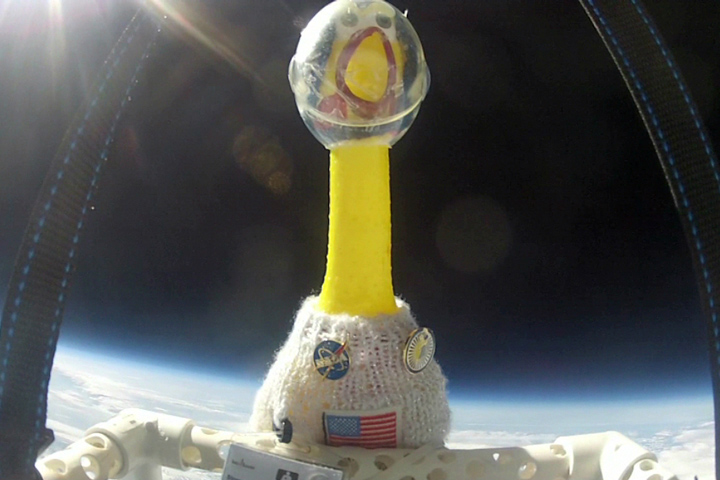http://www.universetoday.com/85464/how-a-rubber-chicken-is-spreading-the-word-about-nasa-space-missions-and-science/ wrote:
How a Rubber Chicken is Spreading the Word about NASA, Space Missions and Science
by Nancy Atkinson on May 6, 2011<<Here’s a headline you don’t see too often: “Rubber Chicken Turned NASA Mission Mascot Embarks on a Flight to Space.” Seriously, this is a true story. If you’ve not heard of Camilla Corona, or Camilla SDO as she is sometimes called, you probably haven’t been paying attention to one of the most exciting current space missions, the Solar Dynamics Observatory. Camilla is virtually everywhere in the world of social media, and she travels around the country – and the planet – spreading the word about what’s going on with our Sun and how SDO is helping us learn more about it. As mission mascot, she is leading the way – and setting the bar pretty high for other NASA missions to follow – about how to get the public interested in space and science.
Camilla Corona: rubber chicken, mission mascot extraordinaire.
“People ask, ‘what does a rubber chicken have to do with a science mission?’, but as long as we get people’s attention, we can then divert it to what SDO does,” said Romeo Durscher, Camilla’s PR assistant and ‘bodyguard.’ “However, we didn’t know it would go this far when we started this.”
The story of Camilla goes back to the early days of SDO at Goddard Space Flight Center, when mission scientist Barbara Thompson introduced Camilla as something funny for the science team. “Barbara was very persistent – she brought little Camillas and rubber chickens to all the science meetings to lighten up the room,” Durscher said.” The question always is, ‘why Camilla?’ and the official answer is because she is the same color as the sun. Over the years, Camilla has just become more and more integrated into the education and public outreach side of the mission. Camilla started as an inter-office joke and soon became the mascot for the science side of the mission,” said Aleya Van Doren, the formal education lead for SDO. “It is not uncommon for someone who has been working on SDO for awhile to receive a rubber chicken as sort of a ‘you’ve earned your keep’ award. She’s a great moral booster for the science team, as well as being a wonderful ‘hook’ to get the public interested in the mission.”
Van Doren said the fun part is bringing Camila to public events or classrooms. “She is a great conversation starter with kids, especially with elementary children. Our main focus is getting the science out to the public, so whatever means we can use to draw in people’s interest and see the amazing things that SDO is doing, we consider it worthwhile. I’ve personally seen children — as well as adults — literally melt when meeting Camilla and get very excited about interacting with her.”
As far as the public side of things, Van Doren said they are pleasantly surprised at the amount of attention her social media channels on Twitter and Facebook have been bringing to the mission. “Romeo does a great job bringing her around to various places. Her schedule is quite full for a chicken. I would be really tired if I was that busy,” Van Doren said.
Which begs the question: just how many Camillas are there? “That is a guarded secret,” Van Doren said, “but there is really only one official Camilla. We are very careful to make sure she is only in one place at a time. But sometimes airfare gets expensive, so she’ll have a body double in one place. Jet-setting around the country can sometimes be difficult.”
Durscher is the keeper of what is now the official Camilla, but confirmed that she does indeed have some body doubles. At first, it was easy to have Camilla be in several places at once. That was before she started wearing clothes. “Our rubber chicken had the SDO mission pin on her left side, and that was Camilla,” Durscher said. “We had one at Goddard, one at Stanford University, and another at our education office, so there were several Camillas, and we had the story that she was travelling here and there, but now it gets a little more complicated.”
“Cynthia is a wonderful person, one of the first followers of Camilla on Twitter and Facebook,” Durscher said. “She really enjoyed what Camilla was doing, and said that Camilla should have a flight suit and that she would make her one. When we got the outfits, we were thrilled. But now we have to have a storyline for why we sometimes we might see Camilla without any clothes on – maybe the suit will be in the dry cleaning, or something.”
Camilla has met astronauts, trained at Johnson Space Center, attended World Space Week in Nigeria and a science fair in Malaysia, been on hand at many NASA Tweet-ups and launches, and even given a speech at the Smithsonain Ignite event at the Smithsonian Museum – well, actually Durscher ended up speaking for her, as Camilla lost her voice shouting at all the animals in the Washington DC Zoo the day before.
But Camilla’s main goal is to educate, inspire (especially to inspire girls to go into science and engineering) to build community and have fun — as well as bringing the beautiful, stunning and wonderful images and data from SDO into the classroom. “We have lots of things teachers can use to educate their students about the Sun — hands-on experiments, beautiful images — and students can have the opportunity interact with mission scientists,” Durscher said. But now Camilla embarks on what might be her greatest adventure ever. She is actually going to space. Camilla will be going to the edge of space in a weather balloon with a camera for the Camilla Space Weather Project. “We are using that launch as the hook for new program we are doing to get the public interested in space weather forecasts,” said Van Doren. Launch is currently scheduled for this weekend, May 8 from the University of Houston central campus. Launch preparations begin at 10 AM, and will be webcast on UStream. “We want to make sure that when Camilla launches it will be safe, so we’ve been having people make a space weather forecast and see whether or not it will be good conditions for launching to the upper atmosphere. Of course we don’t want Camilla to be bombarded with radiation, so classrooms have been making recommendations if this will be a good time to go or not,” Van Doren said. Durscher said that as of Friday, the mission was go.
Camilla is not going to space alone. She’s traveling with Fuzz Aldrin from “Bears on Patrol” which provides US police officers with free teddy bears to use in cases involving small children, as well as a stuffed pig, Skye Bleu, the STEM (science technology engineering and math) outreach mascot for the American Institute of Aeronautics and Astronnautics (AIAA) and a patch to represent Smokey Bear. “Our goal is to inspire the next generation of engineers, scientists and explorers,” Durscher said, “and we’ll make sure that Camilla and her crew will come back alive.” Let’s hope so. Camilla has lots more work to do spreading the word about NASA, space and science.>>
Camilla Embarks on a Flight to Space
- neufer
- Vacationer at Tralfamadore
- Posts: 18805
- Joined: Mon Jan 21, 2008 1:57 pm
- Location: Alexandria, Virginia
Camilla Embarks on a Flight to Space
Art Neuendorffer
- neufer
- Vacationer at Tralfamadore
- Posts: 18805
- Joined: Mon Jan 21, 2008 1:57 pm
- Location: Alexandria, Virginia
Re: Camilla Embarks on a Flight to Space
http://earthobservatory.nasa.gov/IOTD/view.php?id=77787 wrote: <<In March 2012, the Sun unleashed the most intense radiation storm since 2003, peppering satellites with charged particles and igniting strong auroras around both poles. A group of high school students in Bishop, California, knew just what to do: They launched a rubber chicken.
The students inflated a helium balloon and used it to send “Camilla” to an altitude of 120,000 feet (36.5 kilometers), where she was exposed to high-energy solar protons. “We equipped Camilla with sensors to measure the radiation,” said Sam Johnson, age 16, of Bishop Union High School’s Earth to Sky student group. “At the apex of our flight, the payload was above 99 percent of Earth’s atmosphere.”
Launching a rubber chicken into a solar storm might sound strange, but the students had a reason: They are doing an astrobiology project. “Later this year, we plan to launch a species of microbes to find out if they can live at the edge of space,” said team member Rachel Molina, age 17. “This was a reconnaissance flight.”
Many space enthusiasts are already familiar with Camilla, the mascot of NASA’s Solar Dynamics Observatory. With help from her keeper, Romeo Durscher of Stanford University, Camilla corresponds with more than 20,000 followers on Twitter, Facebook, and Google+ about the latest results from NASA’s heliophysics missions.
Camilla actually flew twice: once on March 3, before the radiation storm, and again on March 10, while the storm was raging. On the outside of her space suit—knitted by Cynthia Coer Butcher from Blue Springs, Missouri—Camilla wore a pair of radiation badges, the same kind worn by medical technicians and nuclear workers to assess their dosages.
On March 3, the Earth to Sky team and a local class of fifth graders attached Camilla to the payload, a modified department store lunchbox full of instruments. The payload included four cameras, a cryogenic thermometer, and two GPS trackers. Seven insects and two-dozen sunflower seeds (Helianthus annuus) were also sent up to test their response to near-space travel.
The students adjusted the payload and parachute, inflated the balloon, and released the “stack” into a cloudless blue sky just before local noon. "It was a beautiful lift-off," says Amelia Koske-Phillips, age 15, the team's payload manager and launch boss.
During the two-and-a-half-hour flight, Camilla spent approximately 90 minutes in the stratosphere, where temperatures (-40 to -60C) and air pressures (1 percent of sea level) are akin to those on Mars. The balloon popped at an altitude of 36.5 kilometers, and Camilla parachuted safely back to Earth. The entire payload was recovered intact from a landing site in the Inyo Mountains.
One week later, on March 10, 2012, with a solar storm underway, the students repeated the experiment and Camilla flew into one of the strongest proton storms in years. Sparked by activity in sunspot AR1429, the Sun unleashed more than 50 solar flares during the first two weeks of March. At the peak of the storm from March 7–10, the charged particles hitting Earth's upper atmosphere deposited enough energy to power New York City for two years. At the moment of Camilla's launch on March 10, Earth-orbiting satellites reported solar proton counts at approximately 30,000 times normal.
The fifth grade assistants are now planting the sunflower seeds to see if radiated seeds produce flowers that are different than those grown from the seeds that stayed on Earth. They're also pinning the corpses of the insects—none survived—to a black “Foamboard of Death,” a rare collection of bugs that have been to the edge of space.
Meanwhile, Camilla’s radiation badges have been sent to a commercial laboratory for analysis. The students say they are looking forward to reviewing the data and perhaps sending Camilla back for more. >>
Art Neuendorffer


